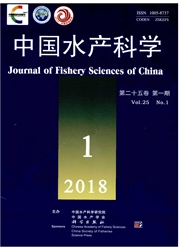

 中文摘要:
中文摘要:
2013年5月至2014年4月,对前三岛海域底层鱼类群落采样调查共渔获鱼类6目15科22种。大泷六线鱼(Hexagrammos otaMi)、许氏平鲉(Sebastes schlegelii)、斑头鱼(Hexagrammos agrammus)和星康吉鳗(Conger myriaster)等属于常年性岩礁鱼类,是该区域鱼类群落的优势种。花鲈(Lateolabrax maculatus)、大头鳕(Gadus maerocephalus)、鳕科和鲭科种类为季节性洄游鱼类。应用典范对应分析(CCA)方法分析了环境因子对鱼类群落结构的影响,结果表明,鱼类时空分布主要受底层水温和底层水体溶解氧含量的影响。斑头鱼、五带高鳍缎虎鱼(Pterogobius zacalles)、褐牙鲆(Paralichthys olivaceus)、铠平鲉(Sebastes hubbsi)、鲐(Scomber japonieus)和高体蛳(Seriola dumerili)资源量与底层水温密切正相关;大头鳕和大泷六线鱼资源量与底层水体溶解氧含量关系最为密切,且大头鳕仅分布在低温季节具有较高溶解氧的深水区;许氏平鲇和星康吉鳗分布区域广泛。基于稳定氮同位素法确定了鱼类营养级,常年性岩礁鱼类位于第三营养级和第四营养级,属于中级肉食性和高级肉食性鱼类;花鲈和大头鳕处于最高营养级(〉4.O),是顶级捕食者。
 英文摘要:
英文摘要:
A series of demersal fish sampling surveys were conducted around the Qiansan Islets from May 2013 to April 2014, and the captured fish were identified to 22 species, 15 families, and 6 orders. Perennial rockfish spe- cies (PRS), including Hexagrammos otakii, Sebastes schlegelii, Hexagrammos agrammus, and Conger myriaster were dominant in the studied area. Lateolabrax maculatus, Gadus macrocephalus, and Carangidae and Scombri- dae species were seasonal migration species. Results of a canonical correspondence analysis used to analyze the effects of environmental factors on fish community structure suggested that the distribution of fish was mainly influenced by bottom-water temperature and dissolved oxygen. Bottom-water temperature had a positive effect on biomass of H. agrammus, Pterogobius zacalles, Paralichthys olivaceus, Sebastes hubbsi, Scomber japonicus, and Seriola dumerili biomass. Biomass of both G macrocephalus and H. otakii was closely related with bottom water dissolved oxygen, and G macrocephalus was only distributed in deep water with high dissolved oxygen during seasons with low temperatures. S. schlegelii, C. myriaster, and S. pachycephalus were widely distributed in the study area. The trophic level results determined using the stable nitrogen isotope method suggested that PRS were in the third and the fourth trophic levels, and that they were intermediate and top carnivores, whereas L. maculatus and G macrocephalus were apex predators above the fourth trophic level.
 同期刊论文项目
同期刊论文项目
 同项目期刊论文
同项目期刊论文
 期刊信息
期刊信息
